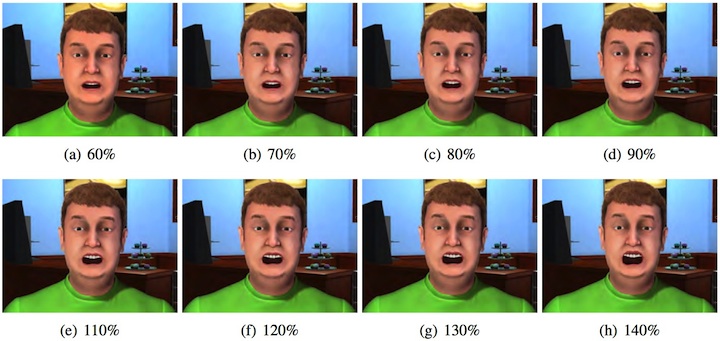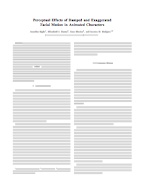Perceptual Effects of Damped and Exaggerated Facial Motion in Animated Characters
Jennifer Hyde1 |
Elizabeth J. Carter2 |
Sara Kiesler3 |
Jessica K. Hodgins1,2 |
| 1Computer Science Department, Carnegie Mellon University | |||
| 2Robotics Institute, Carnegie Mellon University | |||
| 3Human Computer Interaction Institute, Carnegie Mellon University | |||
 Example frames of damped and exaggerated facial motion.
Example frames of damped and exaggerated facial motion.
Abstract
Common guidelines followed in the animation community include the idea that cartoon characters should be exaggerated to better convey emotion and intent, whereas more realistic characters should have "matching" realistic motion. We investigated the effects of rendering style and amount of facial motion on perceptions of character likeability, intelligence, and extraversion. We used cartoon and more realistic-looking characters that were animated with tracked actor motion. The motion was exaggerated and damped in 10% increments up to a 40% difference from the original motion. We discovered that motion changes ± 20% from original motion affected perceptions of likeability and intelligence differently in the realistic-looking and cartoon characters. The realistic-looking characters benefited from increased motion whereas the cartoon characters benefitted from damped motion. Furthermore, the amount of facial motion and perceptions of extraversion were significantly correlated.
Paper

|
Hyde, J., Carter, E.J., Kiesler, S., Hodgins, J.K. "Perceptual Effects of Damped and Exaggerated Facial Motion in Animated Characters," in Proceedings of the 10th IEEE International Conference on Automatic Face and Gesture Recognition (FG 2013). [PDF, bib] |
Video
Acknowledgements
This study was funded by NSF grant CCF-0811450. We thank Brooke Kelly, Moshe Mahler, Tomas Simon, Iain Matthews, our actors, and Disney Research Pittsburgh staff, researchers, and interns for their help with this study.
Copyright notice
© 2013 IEEE. Personal use of this material is permitted. Permission from IEEE must be obtained for all other uses, in any current or future media, including reprinting/republishing this material for advertising or promotional purposes, creating new collective works, for resale or redistribution to servers or lists, or reuse of any copyrighted component of this work in other works.